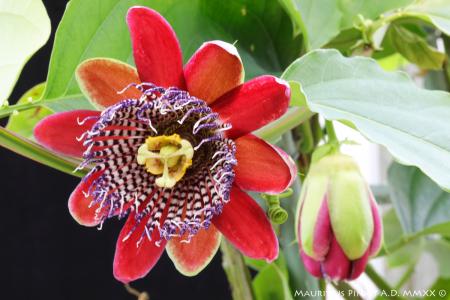
SUBGENUS: passiflora
SUPERSECTION: laurifolia
SERIES: quadrangulares
GEOGRAPHICAL DISTRIBUTION OR ORIGIN:
Northeastern Peru, eastern Brazil.
MINIMUM TEMPERATURE: 5 °C
IDEAL MINIMUM TEMPERATURE: 12 °C
SYNONYMS: P. brasiliana Desf., P. latifolia DC., P. maliformis Vell, (non L.), P. mascarensis Presl., P. mauritiana Du Pet. Thouars, P. oviformis Roemer, P. pyriformis DC., P. sarcosepala Barb. Rodr.
ETYMOLOGY: Denomination referring to the morphology of the square section stem with prominent edges (wings).
NOTES: Chromosomes: 2n = 18.
DESCRIPTION:
The pretty P. alata can easily be grown in a relatively small pot. It is a source of great satisfaction because, when it begins to bloom, it never seems to want to stop. Not even in winter does production of its fragrant flowers completely stop if placed in a warm and bright place.
The intense colour of its flowers recalls the warm areas of origin and their traditional costumes rich in dazzling colours and festive polychromies. All the vitality and energy of the Rio carnival are contained in P. alata, with the explosion of its colours and dances, the warmth of faces and rhythms, the gaiety and vivacity of its people. The sturdy stem, veined in red, has a square section with protruding edges called 'wings'. The leaves are whole, up to 15 cm long and 10 cm wide; they have considerable consistency thanks to the strong and rigid veins. The petiole has at least two pairs of protruding glands.
The flowers, fleshy and strong (about 10 cm in diameter), are characterised by sepals and petals of a beautiful deep red. The large crown is made up of four series of coloured filaments with alternating white and dark red bands, wavy at the apex, protruding from the corolla to create a very pleasant aesthetic effect. Flowering occurs in successive waves and the plant, in this phase, is very beautiful; it is a splendour to see and leaves an unforgettable memory.
The flowers are followed by fruits which are edible, yellow when ripe and ovoid in shape.
Although it is adaptable, it has a limited hardiness (5°C), so it can be grown in the open ground only in milder climatic areas such as Liguria and Sicily. Elsewhere it must be sheltered in a greenhouse or apartment. During the vegetative phase it requires frequent watering, to which a liquid fertiliser should be added weekly. These must be thinned out during the winter rest period.
Multiplication by cuttings is easy and is
the method most recommended for having ready flowering plants. It reproduces
well also by seed.